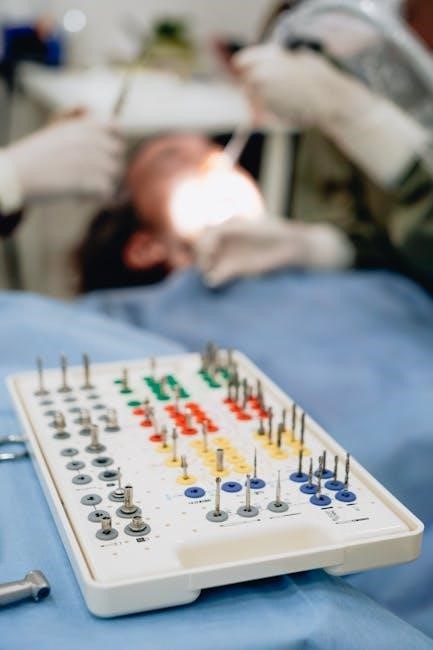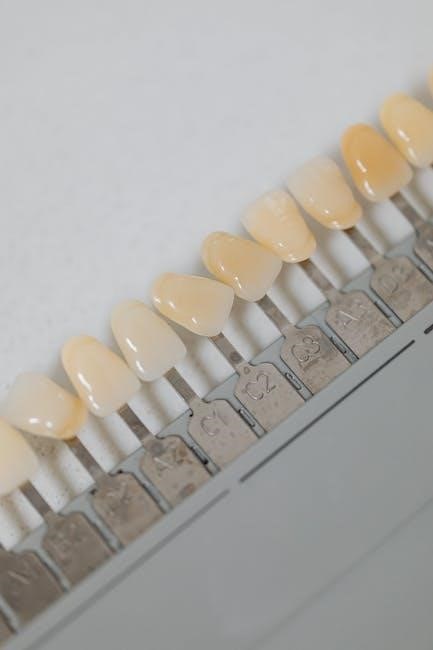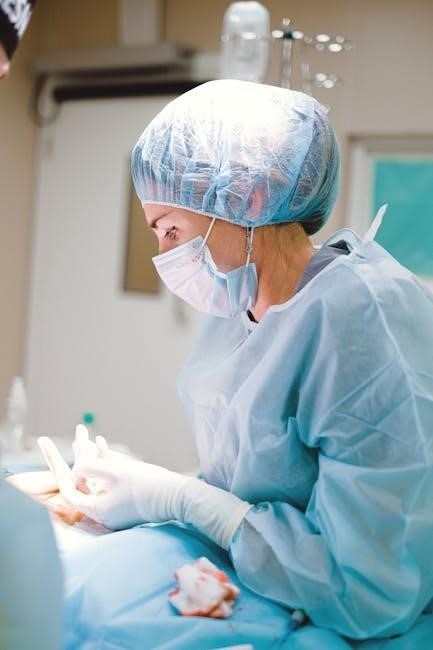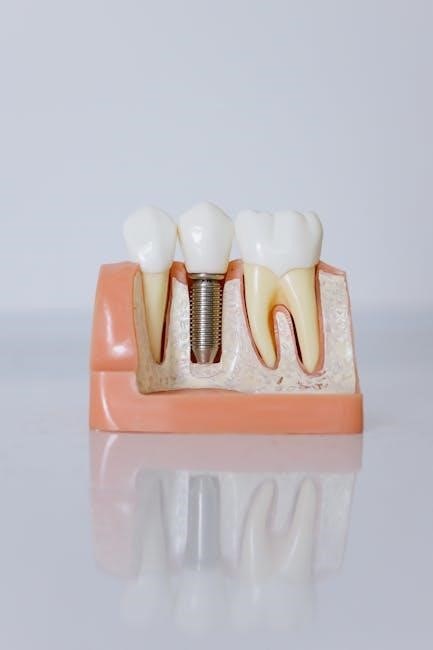Guided implant surgery is a revolutionary dental procedure that uses cutting-edge digital technology to ensure accurate and efficient placement of dental implants, transforming modern implantology for improved patient care significantly․
Definition and Overview
Guided implant surgery is a modern dental procedure that utilizes advanced digital technology to precisely plan and execute the placement of dental implants․ It involves creating a customized surgical guide based on 3D imaging and patient-specific data, ensuring accurate positioning of implants in the jawbone․ This minimally invasive approach enhances surgical precision, reduces complications, and improves aesthetic results, offering a predictable and efficient solution for tooth replacement․
History and Evolution
Guided implant surgery has evolved significantly since the discovery of osseointegration in the 1950s․ Early dental implants were placed using rudimentary techniques, but advancements in imaging and technology led to more precise methods․ The introduction of CT scans in the 1980s revolutionized implant placement planning․ By the 2000s, 3D imaging and CAD/CAM technology enabled the creation of surgical guides, enhancing accuracy․ Today, guided implant surgery combines digital tools and real-time navigation, offering a minimally invasive and highly precise approach to dental implant placement․

How Guided Implant Surgery Works
Guided implant surgery employs advanced digital imaging, 3D printing, and real-time navigation to ensure precise implant placement, significantly enhancing surgical accuracy and efficiency for optimal patient outcomes․
Digital Imaging Techniques
Digital imaging techniques, such as cone beam computed tomography (CBCT) and intraoral scans, play a crucial role in guided implant surgery․ These tools generate high-resolution 3D models of the jawbone, allowing precise identification of optimal implant sites․ By analyzing anatomical structures and bone density, surgeons can avoid critical areas like nerves and sinuses․ The integration of digital imaging enables accurate pre-surgical planning, ensuring implants are placed with minimal invasiveness and maximum stability․ This technology significantly enhances surgical precision and patient outcomes, making it a cornerstone of modern implantology․
3D Printing and Surgical Guides
3D printing is integral to guided implant surgery, enabling the creation of customized surgical guides that direct implant placement with precision․ These guides, fabricated from patient-specific data, are designed to fit the jawbone perfectly, ensuring accurate positioning․ Made from biocompatible materials, they guide drill placement and depth, minimizing errors․ Surgical guides enhance predictability, reduce operative time, and improve surgical outcomes․ This technology allows for tailored solutions, optimizing both functionality and aesthetics, making it a key advancement in modern dental implantology․
Real-Time Navigation Systems
Real-time navigation systems in guided implant surgery utilize advanced tracking technology to monitor surgical tools and implant placement during the procedure․ These systems provide live feedback, allowing surgeons to make precise adjustments for optimal accuracy․ By enhancing control and reducing human error, they improve surgical outcomes․ Real-time navigation also minimizes complications and accelerates recovery, offering a safer and more efficient approach to dental implant placement compared to traditional methods, while maintaining high levels of predictability and patient satisfaction․
Benefits of Guided Implant Surgery
Guided implant surgery offers enhanced precision, minimally invasive procedures, and shorter recovery times, ensuring optimal outcomes with reduced patient discomfort and improved aesthetic results consistently․
Enhanced Precision
Guided implant surgery utilizes advanced digital imaging and 3D modeling to ensure implants are placed with exceptional accuracy․ This precision minimizes the risk of complications, such as nerve damage or improper alignment, and ensures optimal placement for both functionality and aesthetics․ By using detailed digital plans, surgeons can visualize the jawbone and surrounding structures, enabling precise drilling and implant positioning․ This level of accuracy is unparalleled in traditional methods, leading to better outcomes and higher patient satisfaction․
Minimally Invasive Procedure
Guided implant surgery is a minimally invasive procedure that reduces tissue trauma and promotes faster healing․ By using digital planning and surgical guides, surgeons can make smaller incisions and avoid critical structures, minimizing discomfort and swelling․ This approach preserves surrounding bone and gum tissue, ensuring a less invasive experience compared to traditional methods․ Patients benefit from reduced post-operative pain and a faster return to normal activities, making it a more comfortable and efficient treatment option․
Reduced Recovery Time
Guided implant surgery significantly reduces recovery time by minimizing tissue disruption․ The precision of digital planning and surgical guides ensures implants are placed accurately, reducing post-operative swelling and pain․ Patients often experience faster healing due to less trauma to surrounding bone and gum tissue․ This minimally invasive approach leads to shorter downtime, allowing individuals to return to their daily routines and normal oral function more quickly compared to conventional methods, enhancing overall patient comfort and satisfaction․
Improved Aesthetic Results
Guided implant surgery enhances aesthetic outcomes by ensuring precise placement of implants, matching the natural appearance of surrounding teeth․ Digital planning allows for customized positioning, optimizing both function and visual appeal․ The minimally invasive approach preserves gum contours, contributing to a more natural-looking smile․ Additionally, the use of 3D imaging helps in aligning implants with the patient’s facial structure, resulting in harmonious and aesthetically pleasing restorative results that boost patient confidence and satisfaction with their dental transformation․
The Process of Guided Implant Surgery
Guided implant surgery involves precise digital planning, 3D imaging, and real-time navigation to ensure accurate implant placement, minimizing errors and optimizing surgical efficiency and accuracy significantly․
Pre-Surgical Planning and Consultation
Pre-surgical planning involves detailed consultations to assess the patient’s oral health, medical history, and treatment goals․ Advanced imaging techniques, such as CT scans and digital impressions, are used to create precise 3D models of the jawbone․ These models guide the design of surgical templates, ensuring optimal implant placement․ The dentist collaborates with the patient to discuss potential risks, benefits, and alternatives, tailoring the treatment plan to individual needs for a personalized and predictable outcome․ This step is critical for ensuring accuracy and minimizing complications during surgery․
Surgical Procedure Steps
The procedure begins with administering local anesthesia to ensure patient comfort․ A surgical guide, created during pre-planning, is placed over the gums to direct precise implant placement․ Incisions are made, and the implant is inserted into the jawbone following the guide’s markings․ The site is closed, and temporary restorations may be placed․ The entire process is minimally invasive, reducing tissue damage and promoting faster healing․ Post-surgical instructions are provided to aid recovery and ensure optimal implant integration․
Post-Surgical Care and Instructions
Patients are advised to avoid strenuous activities for 24-48 hours post-surgery․ Swelling can be minimized with ice packs applied to the affected area․ A soft food diet is recommended for 1-2 weeks to prevent discomfort․ Smoking should be avoided to promote healing․ Gentle rinsing with saline solution is encouraged to keep the surgical site clean․ Patients should adhere to prescribed pain management and antibiotic regimens․ Follow-up appointments are crucial to monitor healing and ensure proper implant integration․ Proper care fosters optimal recovery and long-term implant success․

Advantages Over Traditional Methods
Guided implant surgery offers enhanced precision, reduced surgical trauma, and faster recovery compared to traditional methods, ensuring more accurate implant placement and improved patient outcomes overall․
Increased Accuracy
Guided implant surgery utilizes advanced digital imaging and 3D modeling to ensure precise implant placement․ This technology allows for accurate planning and execution, minimizing human error․ Surgical guides, created from detailed scans, direct the surgeon to exact positions, ensuring implants align perfectly with the patient’s anatomy․ This level of precision reduces complications and enhances the overall success of the procedure, making guided implant surgery far more accurate than traditional methods․ The use of real-time navigation further refines the process, ensuring optimal results for patients․
Efficiency in Surgery
Guided implant surgery enhances surgical efficiency through precise digital planning and real-time navigation․ Pre-surgical digital models allow for accurate preparation, reducing operation time․ Real-time navigation systems enable surgeons to quickly identify optimal implant positions, streamlining the procedure․ This technology minimizes soft tissue damage and often eliminates the need for sutures, making the process faster and more straightforward․ The integration of advanced tools ensures a seamless surgical experience, optimizing both time and outcomes for patients and clinicians alike․
Higher Patient Satisfaction
Guided implant surgery significantly enhances patient satisfaction by ensuring predictable outcomes and minimizing discomfort․ The use of digital technology allows for precise implant placement, reducing post-operative pain and swelling․ Patients appreciate the minimally invasive approach, which often results in faster recovery and less downtime․ Additionally, the ability to visualize the final aesthetic result beforehand boosts confidence and overall satisfaction․ The combination of accuracy, efficiency, and aesthetic outcomes makes guided implant surgery a preferred choice for patients seeking a positive dental restoration experience․

Indications and Contraindications
Guided implant surgery is ideal for patients with sufficient bone density and stable oral health․ It is contraindicated for those with severe bone loss or active infections․
Suitable Candidates
Suitable Candidates
Suitable candidates for guided implant surgery include individuals with missing teeth, adequate bone density, and good overall oral health․ Patients seeking a precise, minimally invasive procedure benefit most․ Those with conditions like diabetes or osteoporosis may still qualify if well-managed․ Ideal candidates are those requiring single or multiple implants, ensuring proper fit and functionality․ The use of advanced digital technology makes it suitable for patients desiring predictable, aesthetically pleasing results․ Proper patient evaluation is essential to determine eligibility for this modern surgical approach․

Conditions for Contraindication
Conditions for contraindication for guided implant surgery include active gum disease, insufficient bone density, or severe medical conditions like uncontrolled diabetes․ Patients with significant bone loss, untreated periodontal disease, or those who are heavy smokers may not be ideal candidates․ Additionally, individuals with certain systemic health issues, such as bleeding disorders or compromised immune systems, may be contraindicated․ Proper evaluation of overall health and oral conditions is critical to determine suitability for this procedure and ensure safe, effective outcomes․

Cost and Insurance Considerations
Costs vary based on location, surgeon expertise, and technology used․ Insurance typically does not cover guided implant surgery, but some plans may offer partial coverage․ Additional procedures, like bone grafting, increase expenses․
Factors Affecting Cost
The cost of guided implant surgery varies based on factors like location, surgeon expertise, and technology used․ Advanced 3D imaging and custom surgical guides increase expenses․ The number of implants, bone grafting needs, and sinus lifts also influence pricing․ Clinic reputation and geographic location play roles, with urban areas typically costing more․ Additionally, the type of implant and materials used can affect the final cost, making it essential to discuss financial details during consultations to ensure transparency and clarity for patients․
Insurance Coverage and Options
Insurance coverage for guided implant surgery varies depending on the provider and policy․ Some plans may cover part of the procedure if deemed medically necessary, such as for functional restoration․ However, cosmetic aspects are typically not covered; Patients should review their insurance policies and consult with their provider to understand potential benefits and out-of-pocket expenses․ Additional financing options or payment plans may be available to make the procedure more affordable for those with limited coverage․

Technological Advancements
Guided implant surgery leverages CAD/CAM technology, 3D printing, and machine learning for precise implant placement, enhancing surgical accuracy and improving patient outcomes significantly․
CAD/CAM Technology in Dentistry
CAD/CAM (Computer-Aided Design/Computer-Aided Manufacturing) technology has revolutionized dentistry, enabling precise fabrication of dental restorations and implants․ In guided implant surgery, CAD/CAM is used to design surgical guides and prosthetics, ensuring accuracy and customization․ This technology integrates with 3D imaging to create detailed models, allowing for optimal implant placement and improved aesthetic outcomes․ CAD/CAM streamlines the process, reducing errors and enhancing patient satisfaction through tailored solutions․
Role of Machine Learning
Machine learning significantly enhances guided implant surgery by analyzing extensive datasets to predict outcomes and optimize treatment plans․ Through advanced algorithms, ML improves implant placement accuracy and enables real-time surgical adjustments․ It customizes procedures, reduces potential complications, and elevates patient satisfaction by leveraging data-driven insights effectively in modern dental practices․

Potential Risks and Complications
Guided implant surgery, while precise, carries risks like improper placement, nerve damage, or complications from surgical guides, requiring careful planning and skilled execution to minimize these issues․
Common Complications
Common complications in guided implant surgery include improper implant placement, nerve damage, and issues with surgical guides․ Additionally, deep implants may require ultrasound-guided removal, posing further risks․ These complications, while rare, highlight the importance of precise planning and skilled execution to ensure optimal outcomes and minimize potential setbacks for patients undergoing this advanced dental procedure․
Minimizing Risks
Minimizing risks in guided implant surgery involves thorough pre-surgical evaluation, precise 3D imaging, and accurate surgical guides․ Proper sterilization, skilled surgical execution, and adherence to post-operative care reduce complications․ Regular follow-ups ensure optimal healing and functionality, while advanced technology enhances predictability and safety, making guided implant surgery a reliable choice for patients seeking durable and aesthetically pleasing dental restoration solutions with minimized risks of implant failure or post-procedure discomfort․

Case Studies and Real-World Applications
Guided implant surgery has been successfully applied in numerous complex cases, showcasing its precision and reliability․ Real-world examples highlight its effectiveness in challenging anatomical conditions, such as limited bone density or asymmetric jaw structures․ Successful outcomes demonstrate improved aesthetics, functionality, and patient satisfaction, making it a preferred choice for dentists and patients seeking predictable and efficient dental restoration solutions․
Successful Implant Surgery Cases
Guided implant surgery has demonstrated exceptional success in numerous complex cases, particularly for patients with challenging anatomical conditions․ For instance, a patient with severe bone density loss achieved full functional restoration through precisely planned implants․ Another case involved a patient with an asymmetric jaw, where guided surgery ensured optimal implant placement and aesthetic outcomes․ These examples highlight the procedure’s versatility and reliability, offering predictable results and transforming patients’ smiles with minimal complications and faster recovery times;
Lessons Learned from Complex Cases
Complex cases in guided implant surgery have revealed the importance of meticulous pre-surgical planning and real-time adjustments․ For instance, patients with severe bone loss or asymmetric jaws often require customized templates and dynamic navigation systems․ These cases highlight the value of advanced imaging and patient-specific guides to ensure optimal outcomes․ Additionally, the integration of machine learning in predictive analytics has improved accuracy, while post-operative monitoring has refined aftercare strategies, ultimately enhancing the reliability of guided implant procedures in challenging scenarios․
Comparison with Other Dental Restoration Options
Guided implant surgery offers superior accuracy and stability compared to dental bridges or dentures, providing a more durable and aesthetically pleasing solution for tooth replacement․
Versus Dental Bridges
Guided implant surgery offers unparalleled precision and minimally invasive placement, unlike dental bridges that require adjacent teeth preparation․ Implants provide long-term stability and a natural appearance, often lasting over 20 years, compared to bridges that may need replacement sooner․ This method preserves surrounding teeth, promotes better oral health, and prevents jawbone deterioration, making it a preferred choice for modern dental restoration․
Versus Dentures
Guided implant surgery offers a more permanent and natural solution compared to dentures, which are removable and may lack stability․ Implants mimic the look and function of real teeth, providing better chewing efficiency and comfort․ Unlike dentures, implants prevent jawbone deterioration and do not require adjacent teeth modification․ They also eliminate the need for adhesive products and frequent adjustments, offering a more convenient and long-lasting solution for tooth replacement, significantly improving quality of life for patients․
Patient Eligibility Criteria
Patients must have good overall health, sufficient bone density, and healthy gums to qualify for guided implant surgery․ Additionally, they should be free from conditions that may hinder healing or osseointegration, such as uncontrolled diabetes or severe bone loss․ A commitment to proper post-surgical care is also essential for successful implant placement and long-term outcomes․
Anatomical Requirements
Guided implant surgery requires patients to have sufficient bone density in the jaw to support the implant․ Adequate gum health and proper bite alignment are also essential․ The sinus cavity and nerve locations must be carefully evaluated to ensure safe placement․ Anatomical compatibility with the implant size and type is crucial for stability and long-term success․ These factors are thoroughly assessed during pre-surgical planning to ensure optimal outcomes and minimize complications․
Health-Related Factors
Health-related factors play a critical role in determining suitability for guided implant surgery․ Patients must have good overall health to undergo the procedure․ Conditions like gum disease, diabetes, or bone disorders may require pre-treatment․ Smoking and certain medications can impair healing and osseointegration․ Additionally, patients with systemic health issues or compromised immune systems may need special consideration․ Stable health conditions are essential for proper recovery and implant success․ These factors are carefully evaluated during pre-surgical assessments to ensure patient safety and optimal outcomes․

Future of Guided Implant Surgery
The future of guided implant surgery lies in advancing technologies like AI and personalized solutions, promising faster procedures, enhanced outcomes, and more precise implant placements․
Emerging Trends
Emerging trends in guided implant surgery include advancements in AI and machine learning to predict outcomes and optimize planning․ Real-time navigation systems are becoming more prevalent, enhancing accuracy during procedures․ The integration of 3D printing for custom surgical guides and implants is also on the rise, offering personalized solutions․ Additionally, the use of CAD/CAM technology is expanding, allowing for precise implant designs tailored to individual patient anatomy․ These innovations are expected to make the process faster, more efficient, and highly patient-specific․
Innovative Developments
Innovative developments in guided implant surgery are transforming the field․ AI and machine learning are enhancing treatment planning and customization․ 3D printing is enabling the creation of patient-specific surgical guides and implants․ Additionally, advancements in CAD/CAM technology allow for precise, tailored designs․ These innovations are leading to faster, more efficient procedures with improved aesthetic and functional outcomes, setting new standards in modern implantology and patient care․
Guided implant surgery represents a significant advancement in modern dentistry, offering unparalleled precision, aesthetic results, and patient satisfaction through cutting-edge technology and personalized treatment approaches․
Key Takeaways
Guided implant surgery combines advanced digital tools and precise planning to enhance accuracy and predictability in dental implant placement․ It minimizes invasiveness, reduces recovery time, and improves aesthetic outcomes․ By leveraging 3D imaging, surgical guides, and real-time navigation, this approach ensures optimal results tailored to individual patient needs․ The integration of CAD/CAM technology and machine learning further elevates its effectiveness, making it a cornerstone of modern implantology for both simplicity and reliability in achieving long-term success and patient satisfaction․
Final Thoughts
Guided implant surgery represents a significant advancement in dental care, offering unparalleled precision and patient satisfaction․ By integrating cutting-edge technology, it ensures predictable outcomes and minimizes complications․ Patients benefit from shorter recovery times and aesthetically pleasing results․ As technology continues to evolve, guided implant surgery will remain a cornerstone of modern implantology, providing efficient and reliable solutions for tooth replacement․ Its adoption is a testament to the fusion of innovation and patient-centered care in contemporary dentistry․

Leave a Reply
You must be logged in to post a comment.